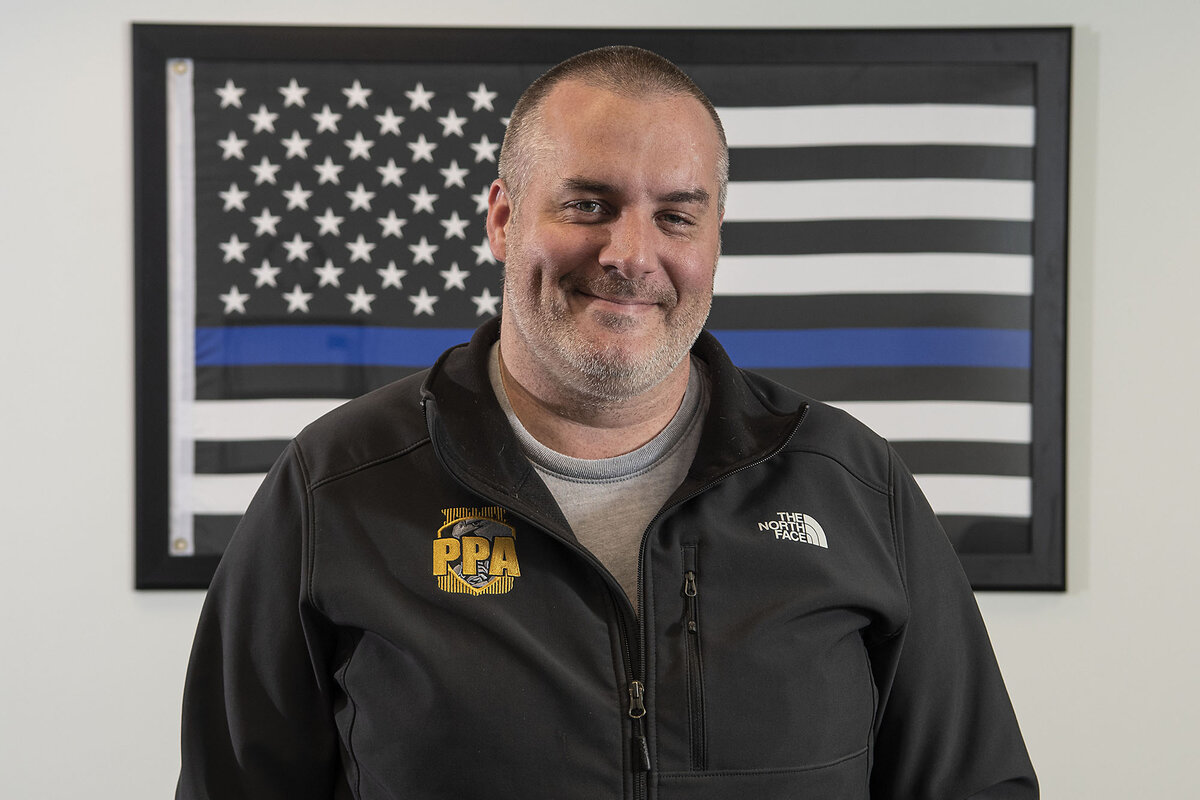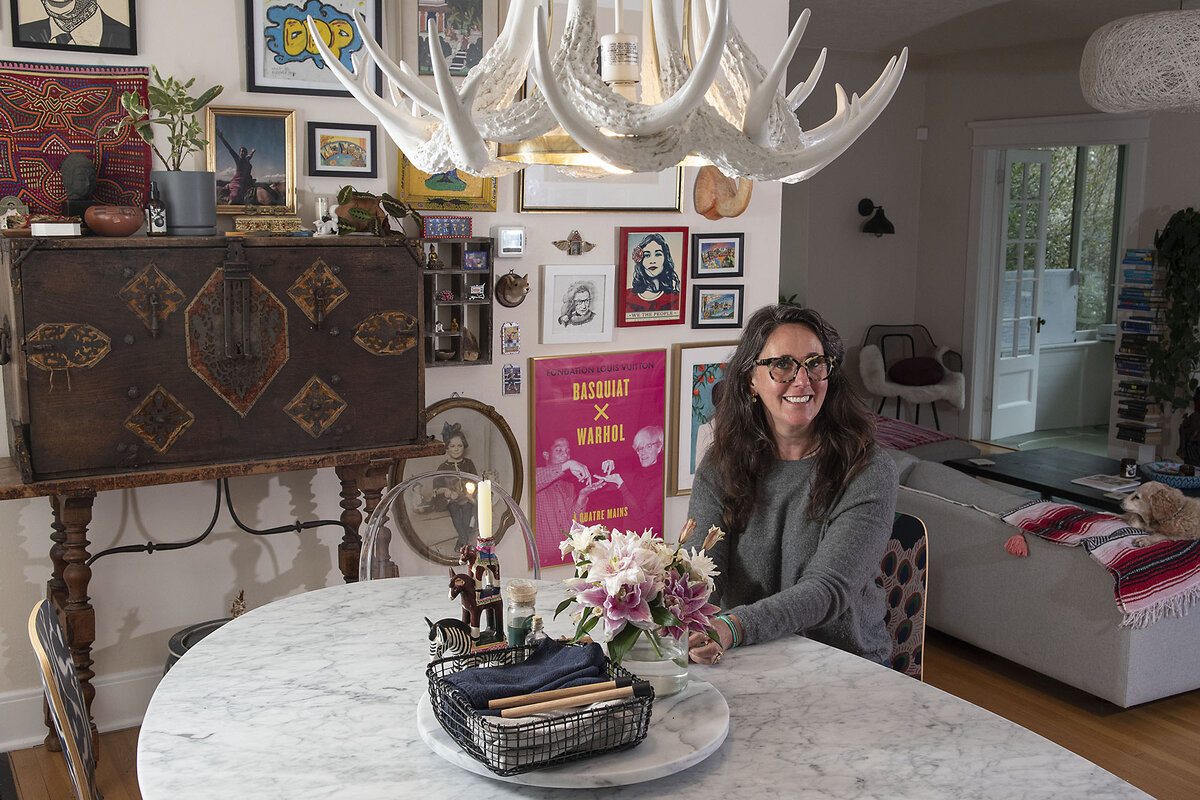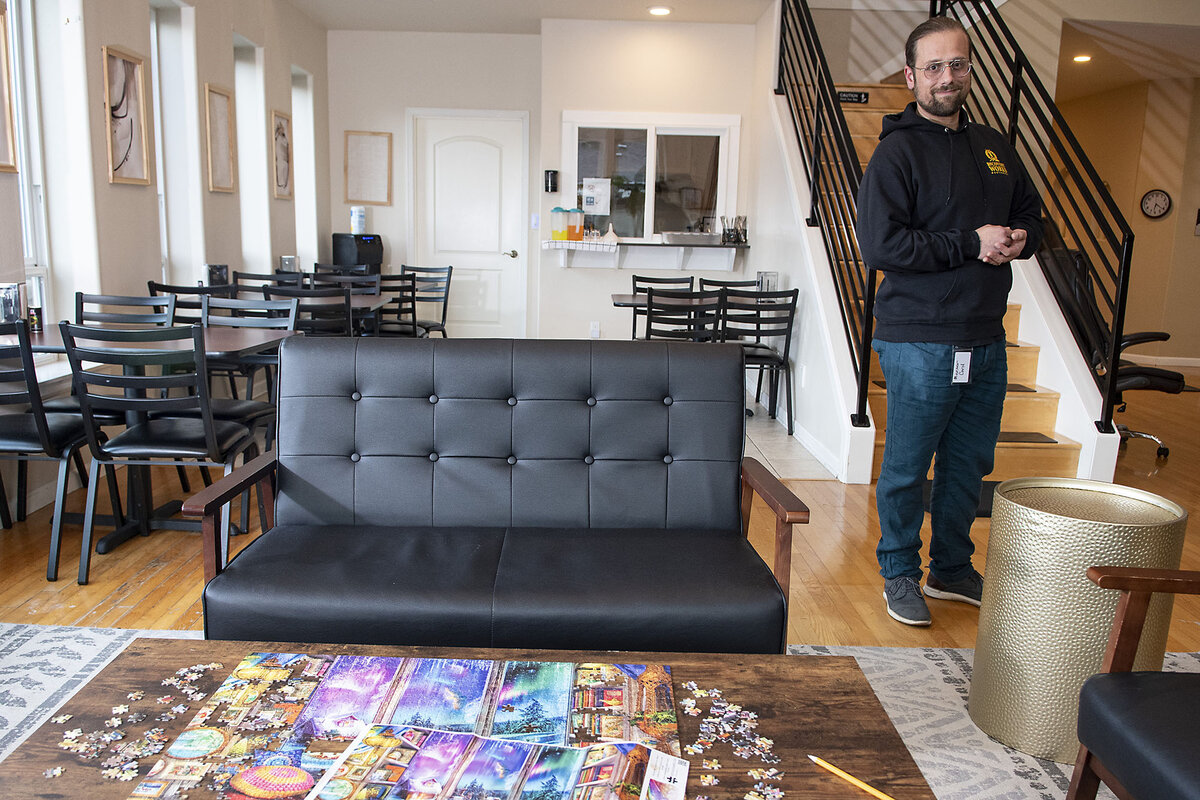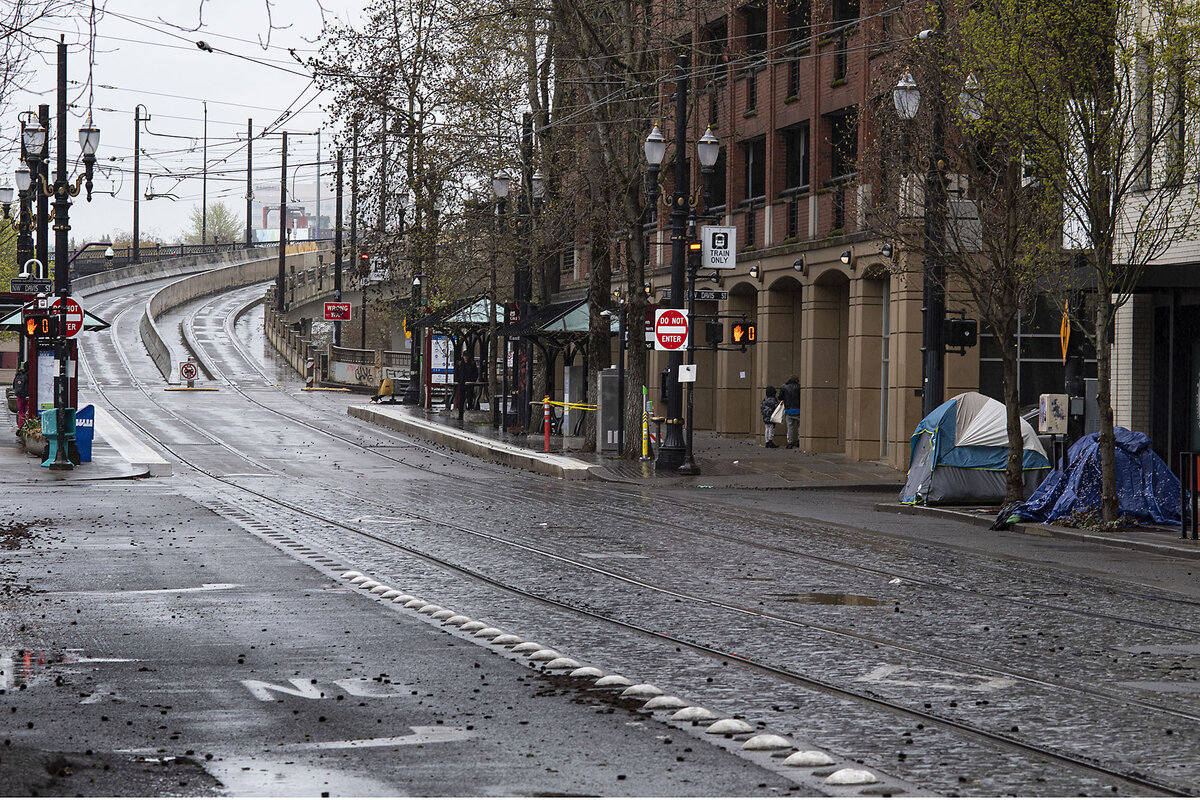Stick, meet Carrot. How Portland police and activists teamed up to fight addiction.
Loading...
| Portland, Ore.
Tera Hurst and Aaron Schmautz found themselves sitting side by side in a van zipping through Portugal. Close quarters. They’d long been accustomed to sitting on opposite sides of Oregon’s State Legislature, battling over drug policy. Would the two longtime adversaries spend the drive exchanging polite pleasantries about the Iberian Peninsula scenery?
Ms. Hurst is the executive director of the Health Justice Recovery Alliance, which represents over 100 addiction recovery groups. Her organization opposes incarceration for drug use. It’s a cause that’s deeply personal to her. As a teenager, she was diagnosed with alcoholism.
“My mom got to a place where she didn’t think I would live past 20, and I didn’t want to,” she recalls. One night, at 3 a.m., she was contemplating suicide. At that lowest of moments, she entered rehab. “I actually had a friend drive me around for four hours waiting with me, because I knew if I went to sleep, I wouldn’t go. I wouldn’t go, and I probably wouldn’t have survived,” she recalls.
Why We Wrote This
A story focused onPortland became famous for a failed drug decriminalization measure. But on a fact-finding trip, the two sides found themselves doing something they rarely did: talking. Out of that, a promising pilot program was born. Part 1 of a series.
Mr. Schmautz is president of the Portland Police Association. He doesn’t want to incarcerate drug users, but he believes public drug use should qualify as a misdemeanor. “When you talk to a lot of people who are suffering from addiction, many of them will tell you that their pathway to sobriety was through the justice system,” he says.
During his 20 years on the job, the second-generation police officer has seen it all. He recounts seeing a man bathing himself in the contents of a port-a-potty that the city provided for homeless people.
“The question becomes, what is compassion for him?” Mr. Schmautz asks. Do you just let him carry on? “Or is it compassionate to take away his freedom and put him in a place where he can actually get help? And honestly, like this is where the conversations are hard.”
Ms. Hurst and Mr. Schmautz previously clashed over the voter-approved passage of Measure 110, which effectively decriminalized drugs for three years. This year, following a wave of public discontent, the Legislature rolled back decriminalization.
Last November, Ms. Hurst and Mr. Schmautz were among 24 Oregonian lawmakers, treatment specialists, and police on a fact-finding mission to Portugal. Ms. Hurst’s organization financed the trip to observe the European nation’s 20-year-old drug decriminalization program. Oregon, like so many other parts of North America and the rest of the world, is trying to figure out how to lower deaths from drug addiction.
Inside the confines of the van, Ms. Hurst and Mr. Schmautz did something they hadn’t really done much of before. They started talking and listening to each other.
The pilot program that resulted from that trip offers promise for a new path forward, one in which both sides are working together. Treatment providers are teaming up with law enforcement to patrol high drug-use areas in Portland. When police intercept drug users in dire situations, rehabilitation specialists are on scene to offer a lifeline. The two groups have long disagreed over the most effective way to get people into treatment. Stick, meet Carrot.
What made the two sides open to change? Answer: Oregon’s drug policy hit rock-bottom. In 2020, voters approved Measure 110. Voters turned against that experiment because crime remained high. Tent encampments proliferated. According to a new Centers for Disease Control and Prevention report, drug deaths in Oregon spiked by 27% last year. The Pacific Northwest bucked an otherwise encouraging trend: the first nationwide decline in fatal overdoses in five years.
In April, the state recriminalized low-level drug possession.
Policy solutions to Oregon’s overlapping homelessness and drug addiction crises require rigorous debate. Here’s what Oregon is discovering about overcoming mistrust between various stakeholders. First, in-person relationship building is essential. Second, when two sides have to solve a problem they each care about, a desire for cooperation can override old feelings of competition. Third, find a common point of agreement as a grit of sand to make the pearl.
“Although there was real disagreement about what to do, there was agreement, for the most part, on the human worth of people who have this problem,” says Keith Humphreys, a professor of psychiatry and behavioral sciences at Stanford University and author of “Addiction: A Very Short Introduction.” “So people were fighting, but they were all fighting for the same thing. They were all upset about overdoses. ... The idea of recovery is, I think, a unifying concept.”
What happened after the 12th arrest
It took 12 arrests for Joe Bazeghi to finally surrender. The man with a heroin addiction was dying. He’d already spent three months in intensive care. Then his girlfriend died of an overdose. One of the cops who responded to that call recognized Mr. Bazeghi. They’d gone to high school together.
“He said, ‘Joe, I’m not going to let you go this time,’” Mr. Bazeghi recalls. “I’m gonna do everything I can to hold you.”
The police officer helped him enter a program to get help. For Mr. Bazeghi, it was a relief.
“I was treatment-ready long before I had access to treatment,” says Mr. Bazeghi, now director of engagement at Recovery Works Northwest, a drug rehabilitation program. “My case was desperate and I knew it. And, therefore, I was willing to accept treatment.”
Today, Mr. Bazeghi is one of the co-founders of Portland’s pilot program.
In Portugal, Mr. Bazeghi also spent time with Mr. Schmautz, whom he describes as a “great guy.” He recalls a pivotal conversation. Mr. Bazeghi, a representative from Portugal’s national institute on drug use, a leader from the Mental Health & Addiction Association of Oregon, and Mr. Schmautz all liked Portugal’s street-team partnerships between police and outreach workers.
“We said, ‘Hey, instead of waiting around, why don’t we pilot getting together?’” says Mr. Bazeghi. “We didn’t wait for a legislature or a mayor’s office or anybody to sign off on it.”
The following month, a police bike squad and treatment providers quietly began working together in the Old Town neighborhood. In April, the successful program was officially expanded to other areas with $683,000 in funding.
Which isn’t to say there isn’t still lingering wariness. Just ask Ms. Hurst and Mr. Schmautz.
“What was important with going on that trip with Aaron, for me, was really understanding that his perspective comes from his job,” says Ms. Hurst, who gained an appreciation for the pressure the police are under to keep a community safe.
In turn, Ms. Hurst shared her perspective that not all drug dealers are predators. Some are trying to feed themselves and, sometimes, a family.
A major fault line is over the most effective way to get people into treatment. Mr. Schmautz favors a tough-love approach; Ms. Hurst, a softer harm reduction that emphasizes creating a safe, humane environment for drug users. They can’t be forced into rehab. They have to be ready for it.
One point of agreement: Oregon can’t arrest its way out of its crisis. It’s a mental health and public health issue and should be handled as such. That’s the Portuguese approach. Oregon is still playing catch-up. Everyone agrees there’s a chronic shortage of beds and detox facilities. That’s why the provision in Measure 110 to fund shelter and drug treatment has been preserved.
The wealth of funding – $211 million in 2024 – has facilitated cooperation among nonprofits that previously saw themselves in competition.
“Measure 110 said, ‘If you want to take one cent from this money, you must coordinate across a system of partnerships that will make up the entire continuum,’” says Mr. Bazeghi, sitting in Recovery Works Northwest offices, yards from a suburban house that’s been converted into a detox center. “In order for us to make money here, we have to work with residential treatment providers, housing providers, support and employment providers.”
The same goes for working with law enforcement.
Yet according to Mr. Schmautz, there are still some in the treatment ecosystem who won’t partner with members of law enforcement because they say they’ll lose credibility with people on the streets.
“Law enforcement in our country has more touch points with people suffering from addiction than anybody else,” continues Mr. Schmautz. “Why would you not then want to be a partner with law enforcement to get people out of that justice system as soon as humanly possible, to give them hope, to give them a different pathway, if you truly care?”
For treatment providers, suspicion of police is rooted in the war on drugs. For decades, it’s resulted in high levels of incarceration –especially among Black people and Latinos.
“The actual culture of law enforcement is problematic because it is built in a kind of fear, militaristic ‘power over’ model,” says Ms. Hurst. “They haven’t built that trust.”
Those misgivings have been underscored by police brutality in the national news, from children being killed in home raids using deadly force to the murder of George Floyd, which sparked a “defund the police” movement.
Mr. Schmautz remembers that backlash in 2020 vividly. He recalls the more than 100 days of rioting in downtown Portland.
“A mob of people broke into an occupied jail and lit it on fire,” he says. “With people in it.”
Demoralized police officers quit in droves.
“Being a police officer is becoming sort of a shameful activity for families that are left-wing or centrist. And so police are [self-]selecting more conservative,” says Stanford University’s Mr. Humphreys, who helped guide drug policy for Presidents George H.W. Bush and Barack Obama. “If that continues, this gets a lot harder because, for health and public health and public safety to work together, they have to at least agree on some shared reality.”
“We cannot ... arrest our way out of these issues”
In an interview at her home, Ms. Hurst pushes back on the claim from some legislators that treatment providers aren’t willing to work with police. She says that if the police feel that way, law enforcement should invite treatment providers to morning roll calls at police stations to dispel their fears and preconceived notions.
“Aaron and I both know that that takes time and that takes buy-in, and he and I can only do so much,” she says.
Mr. Schmautz has tried to model a path. He recalls inviting several treatment providers, who themselves had battled addictions, to the police station for a meeting about the pilot program. They were initially reluctant. Some had arrests and convictions, and they had bad memories of the place. But when the providers showed up, he ushered them into a meeting room that’s off-limits to the public.
“That’s the level of access for people who historically haven’t had it,” says Mr. Schmautz. “When you’re an addict, you feel like you’re just cast out. ... They were emotional. I’m like, ‘We’re going to do this together. I’m not better than you. I’m just a guy doing a job, and you’re a guy doing a job. Let’s do it together.’”
That mutual recognition is already happening at a one-on-one level in the pilot program. Some treatment providers who were formerly incarcerated and living on the streets are now on patrols with law enforcement. When an officer comes across someone asking for help and then does what Ms. Hurst calls “a warm hand-off” to a treatment provider, they can witness firsthand what addiction treatment looks like.
At a leadership level, Ms. Hurst wishes that lawmakers would use their bully pulpit to convene constituents for more of the sorts of conversations that took place in Portugal. But she concedes that relationship building can’t all be incumbent on waiting for the other side to act.
“Aaron and I probably need to get back to talking again,” she says. She’s appreciative that he was willing to go to Portugal and engage in dialogue despite the pushback he received. “We’re not out there usually advocating for the police. We’re advocating for thoughtful, effective strategies. Police have to play a role in this.”
It may be difficult for the two sides to resolve fundamental philosophical disagreements. But the Justice Health Alliance’s website approvingly quotes something that Mr. Schmautz told the statehouse: “Addiction and mental health concerns are a health issue. We cannot and should not attempt to arrest our way out of these issues.”
Mr. Schmautz says that the only way forward is cooperation. Ms. Hurst and Mr. Bazeghi both agree. They still share the common goal of reaching people when they’re at their lowest moment and ready to accept help.
During the winter months of the pilot program, Mr. Bazeghi recalls working alongside officers who’d found a fentanyl user freezing to death in a sleeping bag. The man had a realization: “I don’t want to do this anymore.” That night, he entered a rehab facility.
“If we can make people not feel separated, not feel exiled, feel safe ... then eventually that window is going to present [itself],” says Mr. Bazeghi. “Measure 110 made us work together. We still have a ways to go there. It’s gotten so much better than in 2021 when we started this off.”
Part 2: ‘Our children would not be dead.’ Why these moms are advocating for safe drugs.
Part 3: How Portugal became a world leader in fighting drug addiction









